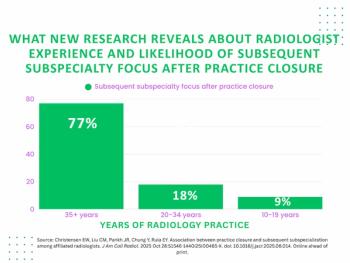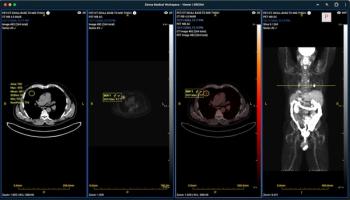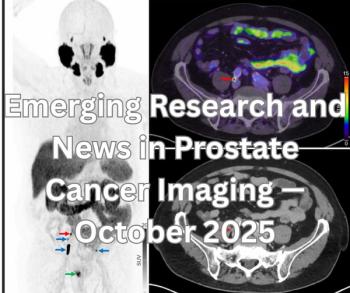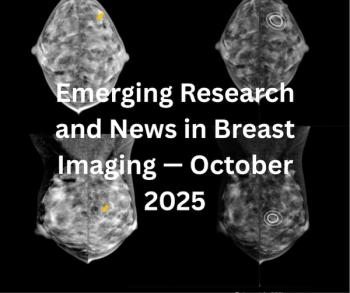
CT Reveals Differences Between COVID-19 and Influenza Pneumonias
Scans reveal differences in lesion locations, mucoid impaction, and pleural effusion.
Since the COVID-19 pandemic began, questions have been swirling about any similarities or differences between COVID-19 pneumonia and pneumonia linked to the flu. A new study, based on findings from CT scans, now shows that, depending on the type of pneumonia, lesions appear differently in the lungs.
In an article released July 9 in the
These details highlight the supplemental role this knowledge can play in helping radiologists identify which patients are fighting COVDI-19. Even with these findings, though, the team, led by Liaoyi Lin, from the First Affiliated Hospital’s radiology department, cautioned that it will still be tough to differentiate between the two pneumonia types.
“CT manifestations of COVID-19 pneumonia and influence virus pneumonia have a large amount of overlap, such that even with the characteristics evaluated using AI software, no significant differences were detected,” they wrote. “Distinguishing between these two types of viral pneumonia with imaging alone is difficult.”
To pinpoint any differences between pneumonia caused by COVID-19 and the influenza virus, the team conducted a retrospective analysis with 97 patients – 49 women and 48 men – who had positive nucleic acid test results for the respective viruses. Their patient records also included CT images and detailed clinical information. Of the group, 52 patients had COVID-19 pneumonia and 45 had influenza virus pneumonia.
CT Findings
Overall, the team did not observe any significant differences in CT scores, length of the largest lesion, mean density, volume, of lesion mass. But, while most features overlap, they said, some statistical differences did emerge.
“Between the group of patients with COVID-19 pneumonia and the group of patients with influenza virus pneumonia, the largest lesion close to the pleura (i.e., no pulmonary parenchyma between the lesion and the pleura), mucoid impaction, presence of pleural effusion, and axial distribution showed statistical difference,” the team wrote.
For axial distribution, the team determined, for COVID-19 pneumonia, it was mostly in the peripheral zone (67.3 percent). Lesions in influenza virus pneumonia had a distribution that was more diffuse (35.6 percent) and random (33.3 percent). The difference in axial distribution suggests, they said, that COVID-19 pneumonia might originate from the subpleural mesenchyme and gradually spread inward.
More specifically, this is what they found:
COVID-19: For patients with COVID-19 infection, the most common main CT feature of the largest lesion was ground-glass opacity (GGO), present in 30 out of 52 patients (57.7 percent), and the largest lesions were close to the pleura in 36 patients (69.2 percent).
CT scans also revealed:
- GGO, 44 patients (84.6 percent)
- Consolidation, 28 patients (53.8 percent)
- Mosaic attenuation, 10 patients (19.2 percent)
- Bronchial wall thickening, 6 patients (11.5 percent)
- Centrilobular nodules, 12 patients (23.1 percent)
- Interlobular septal thickening, 14 patients (26.9 percent)
- Crazy paving pattern, 7 patients (13.5 percent)
- Air bronchogram, 18 patients (34.6 percent)
- Mucoid impaction 1 patient (1.9 percent)
- Pleural effusion, 0 patients
Influenza: GGO was also the most common main CT feature of the largest lesion, appearing in 21 out of 45 patients (46.7 percent), with the largest lesions, again, appearing close to the pleura in 18 patients (40 percent). Still, most lesions were not close to the pleura, the team pointed out. Additionally, they noted that this viral pneumonia has more mucous composition and pleural effusion, likely because the influenza virus affects the large and small airways and lung parenchyma.
CT results also included:
- GGO, 32 patients (71.1 percent)
- Consolidation, 26 patients (57.8 percent)
- Mosaic attenuation, 10 patients (22.2 percent)
- Bronchial wall thickening, 7 patients (15.6 percent)
- Centrilobular nodules, 5 patients (11.1 percent)
- Interlobular septal thickening, 10 patients (22.2 percent)
- Crazy paving pattern, 6 patients (13.3 percent)
- Air bronchogram, 17 patients (37.8 percent)
- Mucoid impaction, 6 patients (13.3 percent)
- Pleural effusion., 10 patients (22.2 percent)
There were also some differences in lesion distribution among patients, the team said. Influenza virus pneumonia patients presented more unilateral lung lesions distribution than did COVID-19 patients – 44.4 percent and 26.9 percent, respectively. However, COVID-19 patient exhibited more bilateral distribution – 73.1 percent compared to 55.6 percent.
Still, even with these differences in findings, the team noted the existing similarities between the two pneumonias make imaging alone an insufficient option for distinguishing between the two.
“CT examinations needs to be combined with clinical indicators for comprehensive evaluation,” they said. “The more important role for CT in the pandemic is in finding lesions and evaluating effects of treatment.”
Newsletter
Stay at the forefront of radiology with the Diagnostic Imaging newsletter, delivering the latest news, clinical insights, and imaging advancements for today’s radiologists.






























